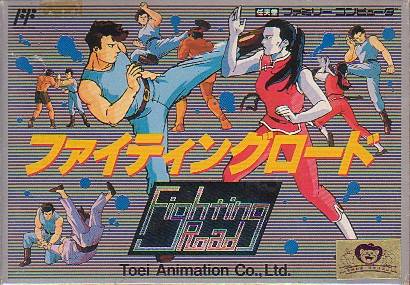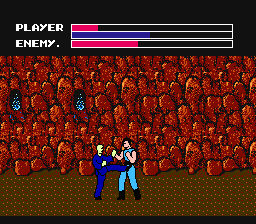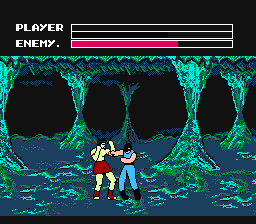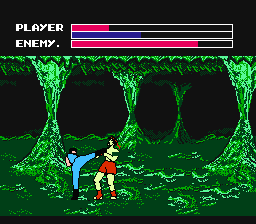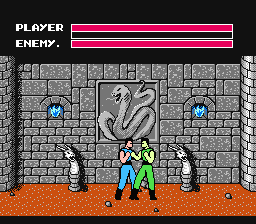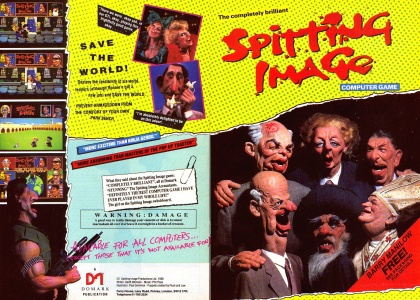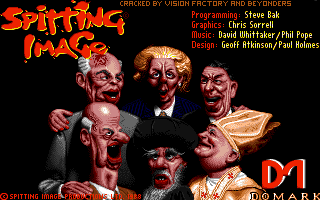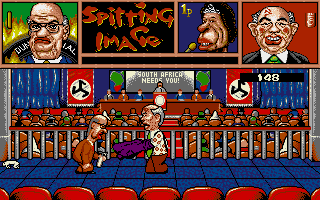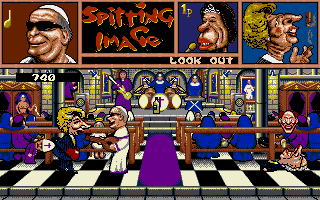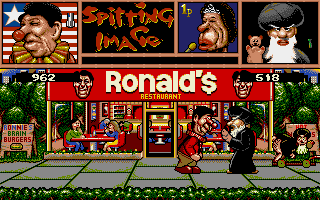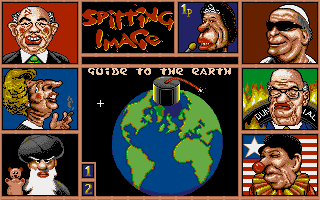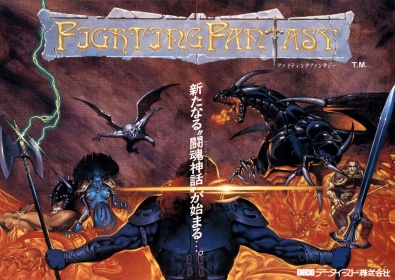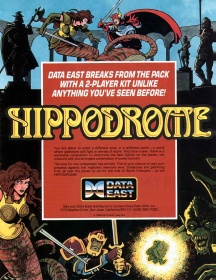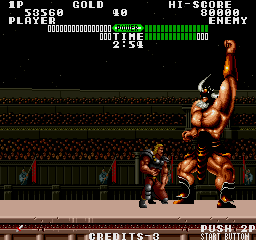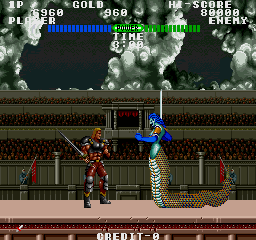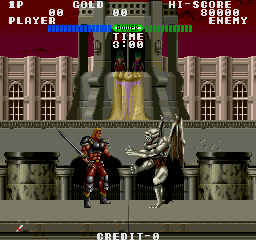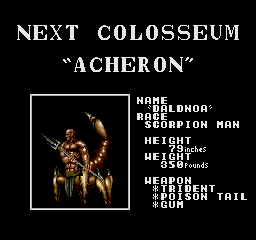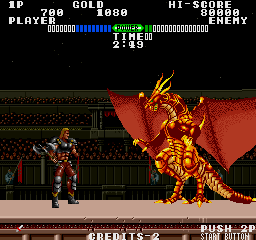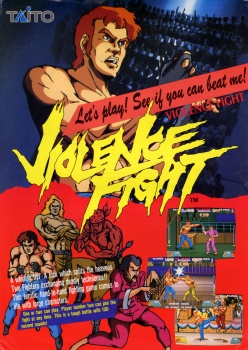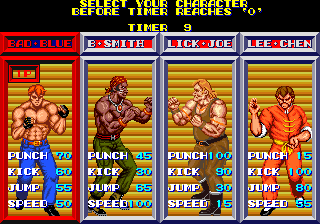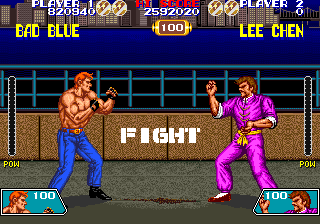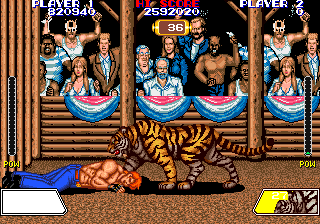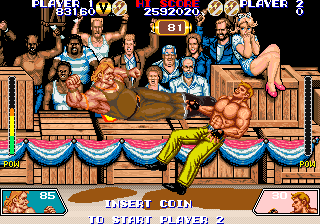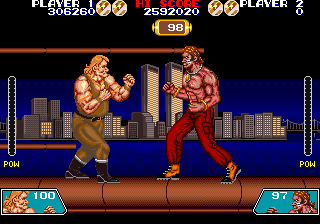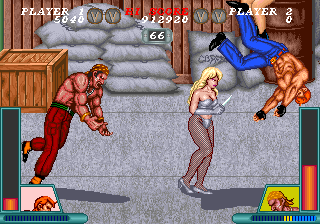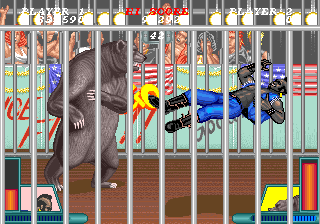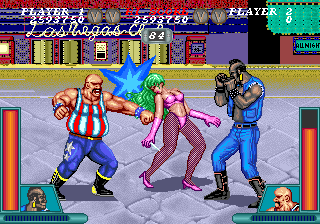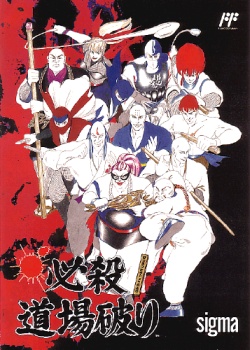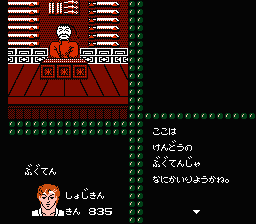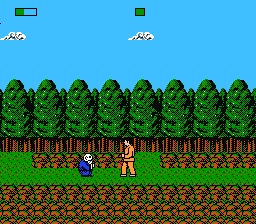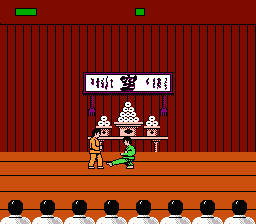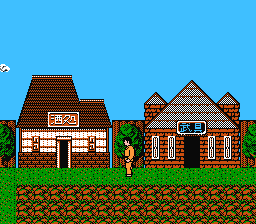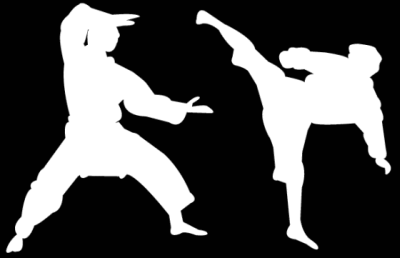
Pre-Street Fighter II Fighting Games
|
Page 1: |
Page 2: |
Page 3: |
Page 4: |
Page 5: |
|
Page 6: |
Page 7: |
Page 8: |
Page 9: |
Page 10: |
|
Page 11: |
Page 12: |
Toei's 1988 entry in the genre is a moderately enjoyable, though extremely difficult game. Each button performs an attack and pressing Up makes the character jump. There is even the standard leg sweep move that trips the opponent. The game does have blocking, which is executed by holding back as an opponent's attack is coming in. Unfortunately, the game lacks multiplayer modes.
For certain special moves in Fighting Road, it's difficult to figure out the exact commands. In between the two combatants' health bar is another meter that builds up when taking damage. Once sufficiently filled, it starts to flash. This announces the chance to launch a fireball attack, but it's very hard to get right, as it can only be launched following upon a special high backflip maneuver. Regardless, it's the first super move bar in the modern sense. To win a match against the computer, they must be defeated twice, but the player's health meter is only partially replenished between rounds.
The audio is not very good and graphics are gaudy as hell with terrible character designs. In all fairness, though, the aesthetic is unique and makes the game stand out among the countless other fighters. The animations are decent, and there seem to be more frames of animation than in most early fighters. The game was planned to be released in the US, but it was cancelled, leaving Fighting Road as a Japan exclusive. That's a shame, as Fighting Road has quite a lot of story text and dialog in between matches.
Quick Info:
|
Developer: |
|
|
Publisher: |
|
|
Genre: |
Fighting Road (Famicom)
Fighting Road (Famicom)
Spitting Image was a British satire show where political figures were lampooned as rubber head puppets. Just the right material for a fighting game, right? Right!? The story is inane drivel about a prophecized world war so terrible that even Switzerland will be involved and Italy already capitulated. There are six playable fighters, puppets that stood at the center of the show's popularity: Margaret Thatcher, Ronald Reagan, Mikhail Gorbachev, Pope John Paul II, PW Botha and the Ayatollah Khomeini. The mysterious villain appears as a boss, but the match is fought in darkness and only his eyes are visible. Queen Elizabeth II is the referee/announcer. Other than the goofy rubber faces, the character's satire personalities don't really show outside of their stage backgrounds: Ronald Reagan's ultra capitalism is shown with a "Ronald'$" restaurant in the background, for example, and the pope, who for some reason is depicted as a rockstar in the show, has a backing band of nuns and priests.
As so often with early fighting games that deviated from the Exploding Fist norm, the controls are intolerable. There is only one attack button and not many moves for variation. Worst is the hit feedback - the according animations are often played with a delay and sometimes not at all, so one almost never knows which attacks hit and which didn't. The characters' health is displayed as a triple digits number. The only redeeming feature that makes Spitting Image worth a mention are the support characters that can be called into the match for a single attack, anticipating the Marvel vs. Capcom series and King of Fighters' Strikers.
Hippodrome, or Fighting Fantasy in Japan, is a weapon based fighting game from Data East. The player controls a generic warrior with a sword who fights an array of monsters.
At the beginning of the game, the player chooses from any of three monsters to fight. After they are all beaten, there are three more monsters to choose from. Then follow battles against two opponents at the same time. At the end stands a final boss that might as well be impossible. The game has hit levels, blocking (hold back and tap the attack button), a jump button, and health points. It also allows attacks to be made in any direction by holding that direction and tapping the attack button (much like the eight directional whipping in Super Castlevania IV). The lone attack can be made straight up while standing or diagonal and up while standing. Though it's interesting to see such an original attack method, the gameplay isn't very good.
After each fight, the winner is rewarded with gold points. The amount of gold received is determined by how much health remains after a fight. Weapon upgrades can be bought with this gold, and a weapon is chosen from the inventory before each fight. Each weapon has different characteristics, like average power with long range, or high power with short range. While the monster fighting theme might make it more noticeable than most of its contemporaries, the gameplay is about as bad as it gets.
Quick Info:
|
Developer: |
|
|
Publisher: |
|
|
Genre: |
|
|
Themes: |
Hippodrome (Arcade)
Hippodrome (Arcade)
Additional Screenshots
Nekketsu Jūdo is quite the ambitious little title. Choose one of four young judoka - one of them a girl - and lead them on their martial arts career through practicing, grade exams and tournaments, from a small regional competition to the olympics. After walking into your local dojo, you are greeted by a friendly judo instructor, who explains to you how things work. You can do some easy training sessions, where you practice falling backwards and loading a sparring partner on your shoulders by hitting the space bar twice with the correct timing. It's as simple as it sounds, but the timing is quite tight and it's easy to get wrong.
The characters have four stats - body strength, speed, attack and defense - but only defense gets ever raised by training, so soon you're going to have to try to reach the next kyu belt in an exam or fight a tournament. The exams are also just fights against a fixed number of opponents, so from here on, you have to learn how the actual fighting works. Which much easier said than done. It's just a lot of pushing and shoving around the dojo (with some very hideous horizontal scrolling), until one of the kids somehow manages to throw the other. If the throw is not a full point to end the match, it even continues with a hold on the floor, but the workings of that are equally elusive, and despite spouting a lot of text, the instructor doesn't actually explain any of it, so until someone ends up finding and scanning the manual (or figuring it all out somehow and writing a FAQ), this game will remain practically impenetrable, even much more so than Uchi-Mata before.
Quick Info:
|
Developer: |
|
|
Publisher: |
|
|
Genre: |
Nekketsu Jūdo (MSX2)
Nekketsu Jūdo (MSX2)
Additional Screenshots
Violence Fight (バイオレンスファイト) - Arcade, PlayStation 2, Xbox (1989)
Solitary Fighter (ソリタリーファイター) - Arcade (1991)
Taito's Violence Fight is Pit-Fighter if it were a bazillion times less horrible. It ain't good, though. There are four characters: Bad Blue is blue enough a dude to rescue the president. This is not a joke. Ben Smith is the game's beat-em-up style high-speed-low-power character. Lick Joe is the game's beat-em-up style tank character. He is slow as all hell, but powerful and is al- ... wait, what the hell!? Lick Joe?! The Japanese Wikipedia actually refers to him as Rick Joe, so it might be a typo, even though the game and accompanying materials are consistent with the weird spelling. Lee Chen is just a generic kung-fu character.
Ever seen any Jean Claude Van Damme movie? That's the plot. A badass street fighter gets himself caught up in a life of kick boxing and gambling. According to the scrolling storyline: In early 1950s America "a game called 'violence fight' was in vogue among mafia, reckless drivers and general business men." This game was "to struggle" for the title of the greatest "quarreler" in America. "And of course" they got money as well. "And of course"? The game says that like it does not need to be said. Bad Blue is the hero and he and his manager seek for the prize money. "As a matter of fact" will Bad win it all? That is up to you! However awesomely bad the Engrish is in this game, no amount of campiness can save this thing.
There are two attack buttons and a single jump button. The game plays like Pit-Fighter, as noted, which should say something about its lack of quality. Each character has individual moves, but given that they are all boring to play as it really does nothing to make the game more enjoyable. Even the bonus round where the player fights against a tiger is surprisingly boring. The only really innovative part about are the crates and barrels combatants can be smashed into, and it's even possible to pick them up and throw them.
The major appeal of the graphics and audio is the unintentional humor. The character designs and graphics are laughably ridiculous. Despite the supposed setting in 1950s America, the whole game oozes with campy '80s charm. Like in Data East's Captain America and the Avengers, there are all kinds of comic book-style "noises" that don't even seem appropriate for what they're depicting. In all fairness, whatever injury makes the noise "GOON" probably hurts like hell.
Violence Fight received a sequel in 1991, which was technically released after Street Fighter II, but according to internet lore only three weeks part the two. Internet sources also claim that this update was originally called Violence Fight II in Japan, but there is no solid proof to that claim. The only available versions are named Solitary Fighter. It's generally the same game, although the two bosses from the original are playable here. When fighting in the wider arenas, mostly female mooks keep appearing one at a time to support the main opponent, which are taken out with a few hits, but nonetheless very annoying. The bonus rounds add a bear to the tiger, but both fights now take places in cages with bars so thick that it's sometimes hard to see what's going on.
Violence Fight was not ported to home consoles in its time, but included as part of the Taito Legends 2 collection for the PlayStation 2 and Xbox (where for some reason it was removed in the US version). Solitary Fighter is missing in action, though
Quick Info:
|
Developer: |
|
|
Publisher: |
|
|
Designer: |
|
|
Genre: |
|
|
Themes: |
Violence Fight (Arcade)
Violence Fight (Arcade)
Violence Fight (Arcade)
Additional Screenshots
Hissatsu Doujou Yaburi is a fighter/RPG hybrid developed by Sigma and released for the Famicom in 1989. It is a very repetitive game, but it is definitely interesting. The game starts after you choose any of the three characters. Since this game is an RPG as well as fighter, the game starts off in a village. Attacking is impossible outside of battle mode, so these town portions are much like those of any traditional RPG. There are shops, places to save, places to heal, and someone to talk to. When venturing outside of the village, the player will see enemies inhabiting the environment. Approaching them initiates a battle mode, which plays like a fighting game. There is a kick, a punch, down ducks and up jumps. Pressing down while in the air causes the character to fall back to the ground faster. This jump-then-hit-down-and-kick-before-landing strategy is a good tactic to use against shorter opponents, as they are difficult to hit while standing. It is also possible to execute Mortal Kombat style hop kicks against most opponents.
Inside the villages are rather large buildings where tournaments take place. Each tournament involves a number of matches with a boss at the end. These tournaments can get rather difficult with the amount of characters to fight. Therein lies the biggest problem with the game: its difficulty. The fights are generally easy enough but health isn't restored after a fight. Since it's necessary to replenish health regularly, the game requires way too much backtracking to healers, basically after every other fight. Certain fights, especially bosses, can get even more difficult. It's impossible to control characters as fluidly as the computer opponents move. While certain opponents require two knock downs to be defeated, the playable character is finished as soon as his life meter is depleted only once.
The fights are moderately enjoyable at first, but ultimately they are all the same. There is no blocking and really no strategy, other than the aforementioned jumping tricks.
Quick Info:
|
Developer: |
|
|
Publisher: |
|
|
Genre: |
|
|
Themes: |
Hissatsu Dōjō Yaburi (Famicom)
Hissatsu Dōjō Yaburi (Famicom)
|
Page 1: |
Page 2: |
Page 3: |
Page 4: |
Page 5: |
|
Page 6: |
Page 7: |
Page 8: |
Page 9: |
Page 10: |
|
Page 11: |
Page 12: |
